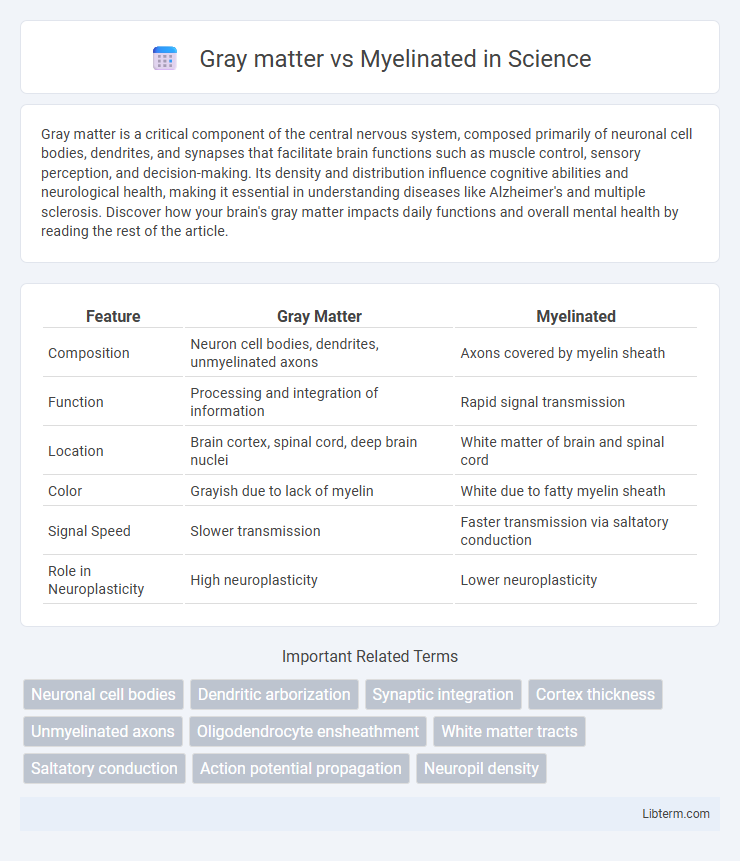Gray matter is a critical component of the central nervous system, composed primarily of neuronal cell bodies, dendrites, and synapses that facilitate brain functions such as muscle control, sensory perception, and decision-making. Its density and distribution influence cognitive abilities and neurological health, making it essential in understanding diseases like Alzheimer's and multiple sclerosis. Discover how your brain's gray matter impacts daily functions and overall mental health by reading the rest of the article.
Table of Comparison
| Feature | Gray Matter | Myelinated |
|---|---|---|
| Composition | Neuron cell bodies, dendrites, unmyelinated axons | Axons covered by myelin sheath |
| Function | Processing and integration of information | Rapid signal transmission |
| Location | Brain cortex, spinal cord, deep brain nuclei | White matter of brain and spinal cord |
| Color | Grayish due to lack of myelin | White due to fatty myelin sheath |
| Signal Speed | Slower transmission | Faster transmission via saltatory conduction |
| Role in Neuroplasticity | High neuroplasticity | Lower neuroplasticity |
Introduction to Gray Matter and Myelinated Tissue
Gray matter consists primarily of neuronal cell bodies, dendrites, and unmyelinated axons, playing a crucial role in processing and integrating information in the central nervous system. Myelinated tissue, composed of axons encased in myelin sheaths formed by oligodendrocytes in the CNS and Schwann cells in the PNS, facilitates rapid electrical signal conduction. The contrast between gray matter and myelinated tissue underlines their distinct functions in neural communication and brain organization.
Structural Differences Between Gray Matter and Myelin
Gray matter consists primarily of neuronal cell bodies, dendrites, and unmyelinated axons, giving it a dense and darker appearance in the brain and spinal cord. Myelin, a fatty substance produced by oligodendrocytes in the central nervous system and Schwann cells in the peripheral nervous system, surrounds axons to form the white matter due to its high lipid content and insulation properties. Structurally, gray matter is rich in synapses and cellular components for processing information, while myelinated fibers enhance rapid signal transmission through saltatory conduction along the axons.
Composition: Neurons vs. Axons
Gray matter primarily consists of neuronal cell bodies, dendrites, and unmyelinated axons, facilitating synaptic communication and processing within the central nervous system. Myelinated regions, such as white matter, are rich in axons wrapped in myelin sheaths produced by oligodendrocytes, which enhance the speed and efficiency of electrical signal transmission. The distinct composition reflects their functional specialization: gray matter for information processing and myelinated fibers for rapid signal conduction.
Functional Roles in the Nervous System
Gray matter primarily processes information through neuronal cell bodies, dendrites, and synapses, enabling functions like muscle control, sensory perception, memory, and decision-making. Myelinated fibers, found in white matter, facilitate rapid electrical signal transmission between different brain regions and the spinal cord, enhancing communication speed and coordination. The integration of gray matter's processing capabilities with the fast conduction of myelinated axons is essential for efficient nervous system performance.
Locations in the Brain and Spinal Cord
Gray matter is primarily located in the cerebral cortex, basal ganglia, and the central portion of the spinal cord, containing neuronal cell bodies, dendrites, and synapses. Myelinated white matter is found in the deeper parts of the brain, including the corpus callosum and internal capsule, as well as the outer regions of the spinal cord, consisting of myelinated axons that facilitate rapid signal transmission. The distinct distribution of gray and white matter supports specialized functions in processing and communication within the central nervous system.
Myelination and Signal Transmission Speed
Myelination significantly enhances signal transmission speed by insulating axons with a fatty layer called the myelin sheath, allowing electrical impulses to jump between nodes of Ranvier in a process called saltatory conduction. In contrast, gray matter, composed primarily of unmyelinated neurons and synapses, processes information more slowly due to continuous conduction along axons. Efficient myelination in white matter regions facilitates rapid communication between different brain areas, crucial for complex cognitive and motor functions.
Gray Matter in Cognitive Processing
Gray matter, composed primarily of neuronal cell bodies, dendrites, and unmyelinated axons, plays a crucial role in cognitive processing by facilitating synaptic integration and neural communication within the brain. It is densely packed in regions such as the cerebral cortex and hippocampus, which are essential for memory, attention, and decision-making functions. Unlike myelinated white matter, gray matter supports complex information processing and neural plasticity, enabling adaptive learning and higher-order thinking.
Impact of Disease on Gray and Myelinated Regions
Neurodegenerative diseases such as multiple sclerosis predominantly affect myelinated regions by causing demyelination, leading to impaired neural signal transmission and cognitive decline. Gray matter damage, often observed in Alzheimer's disease, results in neuronal loss and synaptic dysfunction, severely impacting memory and cognitive functions. Both gray and myelinated regions suffer structural and functional impairments, but the specific impact varies with disease pathology, influencing clinical symptoms and progression.
Development and Age-Related Changes
Gray matter volume peaks in childhood and gradually declines with age due to synaptic pruning and neuronal loss, impacting cognitive functions over time. Myelinated white matter increases during development, enhancing neural transmission speed, but shows degeneration in aging, contributing to slower processing and decreased connectivity. Age-related changes in both gray matter and myelinated tracts are linked to cognitive decline and neurodegenerative disorders.
Advances in Imaging Gray Matter and Myelinated Tissue
Advances in imaging technology, such as high-resolution MRI and diffusion tensor imaging (DTI), have significantly improved the visualization and differentiation of gray matter and myelinated white matter in the brain. Techniques like quantitative T1 mapping and myelin water imaging provide precise measurements of myelin content and its distribution, enabling detailed assessment of myelinated tissue integrity. Improved imaging of gray matter morphology, including cortical thickness and volume, aids in understanding neurodegenerative diseases and brain development.
Gray matter Infographic

 libterm.com
libterm.com